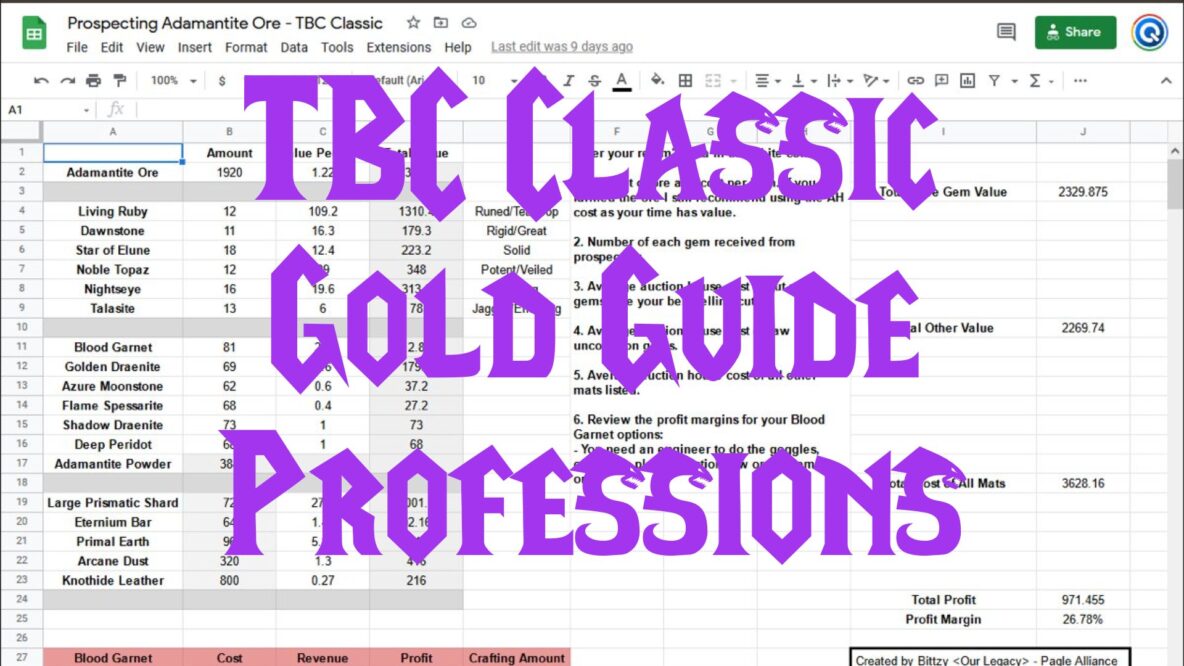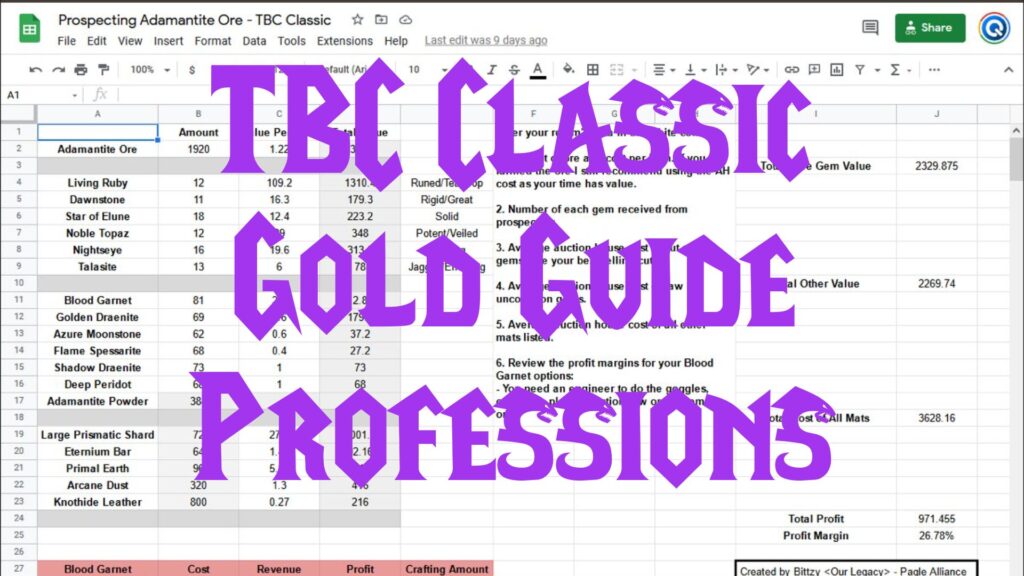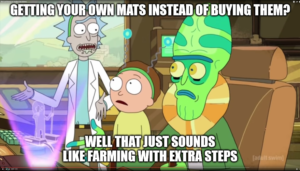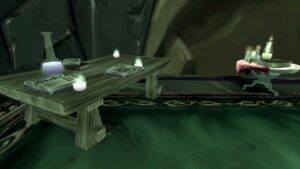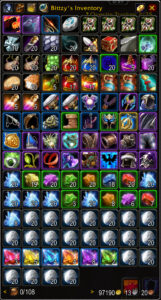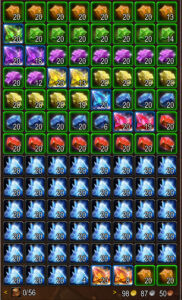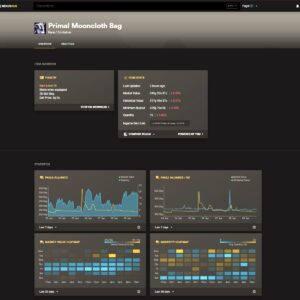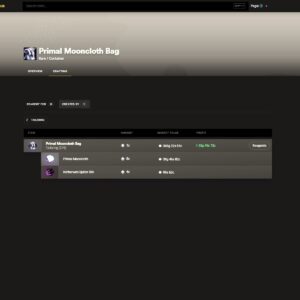Professions offer a different playstyle for making gold than questing and farming mobs. Non-gathering professions also have better gold per hour scaling. But there is a higher barrier to entry and not all professions are created equal. Making gold in TBC Classic with professions will depend on if you happen to have an exploitable profession already. Or if you’re willing to put in time and capital for a later payout.
Alchemy | Enchanting | Engineering | Jewelcrafting | Leatherworking | Tailoring
Review of RestedXP for Profession Gold Making
Check out the main TBC Classic gold guide for more information on gathering professions and making better sales at the auction house.
Should You Focus On Professions for Gold In TBC Classic?
There are two big factors to consider before you dive into using professions to make gold in TBC Classic.
One, do you have enough gold already to support buying mats and, if needed, recipes? Making gold with professions requires an investment in the profession itself and enough starting capital to buy the mats needed to make what you plan to sell. If you aren’t buying mats you’re spending a lot more time farming.
Two, do you have one or more of the viable crafting professions available already?
Strong gold makers:
- Alchemy
- Jewelcrafting
Decent gold makers:
- Engineering
- Leatherworking
- Tailoring
Non-viable professions:
- Blacksmithing
- Enchanting (helpful on an alt or decent with a tank who runs lots of dungeons)
- Cooking
The playstyle with professions is sitting around the cities, buying mats, crafting, then turning your goods into profit. Initial setup takes some time and startup gold. But once running smoothly it can be great gold per hour and scales better than other options. Crafting in bulk takes time, but you can do it while AFK and without worrying about interference from other players.
I personally made my fortune with alchemy in WoW Classic. I then doubled it in TBC Classic with jewelcrafting. So I have a strong bias toward using professions for gold-making. But what worked well for me won’t always work well for everyone.
Alchemy
Making gold with the alchemy depends on your alchemy mastery (aka specializations). Most elixirs, flasks, and potions sell at or near their material cost. The profit comes from the additional items created by your specialization’s proc rate. That rate is around 20%, but you need to craft in bulk to see that proc rate reliably.
If you already have a mastery you like and recipes to support it then stick with it. No mastery is superior to the others by mid-TBC Classic. That said, if you’re new to alchemy I would go with Elixir Mastery if you want to actively craft. Or Transmutation Mastery if you want a daily cooldown and done approach.
Elixir Mastery
These elixirs and flasks are your best bets for good sales and making a consistent profit. Sell elixirs in stacks of 5 and 20 and flasks in stacks of 5.
- The recipe is a world drop that’ll cost you some gold, so see how its cost/profit compared to other options.
- If you need discoveries this is a great option, but otherwise, its profit margin is too low for my taste.
When buying mats your cost should be equal to or less than the average sales price x 0.95 (auction house fee). If mat cost = revenue that’s okay, you’ll make ~20% profit selling the extra procs.
Create big batches to get the best chance of evening out your proc rate. As you get more comfortable with making sales you can increase batch sizes.
Make and sell everything on the list which is profitable (except Adept’s Elixir if done with discoveries). The larger your selection the more consistent your sales.
Potion Mastery
These potions are your best bets for good sales and making a consistent profit. Sell all potions in stacks of 5.
- Slower sales and likely less profit, but an easy to get the recipe
- The recipe is an expensive world drop. Figure out how many pots you’ll need to make to break even, then see if it is worth the investment.
- Another expensive world drop recipe.
If you can’t afford (or justify) the two expensive recipes then you should really consider changing to Elixir Mastery.
When buying mats your cost should be equal to or less than the average sales price x 0.95 (auction house fee). If mat cost = revenue that’s okay, you’ll make ~20% profit selling the extra procs.
Create big batches to get the best chance of evening out your proc rate. As you get more comfortable with making sales you can increase batch sizes.
Ideally, you should be making and selling both Destruction and Haste potions to maintain consistent sales.
Transmutation Mastery
With transmutation, you just do one a day and call it done. It is important to keep enough mats on hand so you don’t miss a day. Expect the proc rate to feel hit or miss as you aren’t making big batches to even things out. But on the bright side, every transmutation should be profitable without a proc.
- The default transmutation for a reason. It is in demand from the start to the end of TBC Classic.
- Sell Primal Mights in stacks of 1.
- This may be a better option if you also have a jewelcrafter. Transmute this meta gem and then cut and sell a Relentless Earthstorm Diamond.
- A good option if you also have a jewelcrafter. Transmute this meta gem and then cut and sell a Chaotic Skyfire Diamond.
- Mats cost a bit more than an Earthstorm Diamond, but it also sells for more. Compare their profit margins if you want to focus on just one over the other.
Enchanting – A Supplemental Profession for Making Gold In TBC Classic
Making gold with enchanting mostly centers around disenchanting, not actual enchanting. The time involved in hawking your services prevents you from earning good gold per hour compared to other options. While being able to disenchant other items made with other professions will open up more gold-making options in TBC Classic.
Disenchanting
Enchanting on any character can synergize well if you also have engineering, jewelcrafting, or tailoring on any other character. It is also nice during the leveling up of a new character or if you do a lot of open-world farming, as both see a higher number of green items drop for disenchanting. You only need to skill up enchanting to 300 to disenchant any Outland item.
- Almost all Outland greens (except for weapons) are worth more disenchanted than sold to a vendor. With weapons, you are usually better off selling them to a vendor.
- Green items are not worth posting to the auction house. They have low sell rates, offer a small profit over enchanting mats, and the auction house fees can quickly turn an item into a loss.
- Likewise, most blue items are also worth more disenchanted. Check the price of Outland blue items on your auction house. On my server (Pagle-Alliance) they are worth about the same as Large Prismatic Shards (which they disenchant into). In that case, you are better off disenchanting them. Shards sell much faster and have no auction house fee.
- Engineering, jewelcrafting, and tailoring can all make blue items that don’t sell well but cost less than the cost of a Large Prismatic Shard. Bulk disenchanting opens up another revenue stream for those professions.
Tanks & Dungeons
Tanks who run dungeons can use enchanting to make their runs more profitable. You can offer tanking services in exchange for all unwanted blue items. Either make the offer to a group looking for a tank or start your own run, advertising that stipulation. In the end, you should end up with a few Large Prismatic Shards for your effort.
Invest In Enchanting for Future Content
If you don’t have a toon with enchanting consider it for a long-term investment. You’ll need a level 35+ character and they’ll need to skill up to 300. That will cost you some gold, so this is more about convenience than profit in the short term. Where this will really start to pay off is in Wrath of the Lich King Classic.
In WotLK Classic you’ll start leveling again, as well as run daily events for reputation. All that means more green item drops than what you get just from heroics and raids. There will also be professionally crafted items made more valuable through disenchanting. For WotLK Classic disenchanting you’ll need to use a level 50+ character with an enchanting skill of 350.
Engineering
You should pick engineering as a profession for its gadgets, whether you’re trying to min/max or just want to add some fun. But engineering does offer several good gold-making items, especially if you went with the goblin specialization. Enough so that I regularly make use of an alt with engineering to increase my sales volume from time to time.
Engineering Items
- An engineer’s bread and butter item provided you went with goblin engineering. Any engineer can use them, but only the goblin specialists can craft them.
- When calculating materials keep in mind you get four Elemental Blasting Powders per craft and two Super Sapper Charges per craft. So a stack of 10 will require 20 Netherweave Cloth, 10 Mote of Earth, 5 Mote of Fire, and 5 Primal Mana.
- Sell the sapper charges in stacks of 10.
- Only look at crafting these goggles if you have access to an enchanter with 300+ skill.
- The goggles themselves don’t sell, but they can be disenchanted into Large Prismatic Shards which sell very well.
- Check the cost of materials against the going rate for shards. These work best if you have access to “free” Blood Garnets through mining or prospecting.
- Sell the shards in stacks of 4 and 8.
Outland Scopes
When starting to sell scopes begin with a small inventory and make as many different kinds as you can. You want to see what sells well and offers consistent profits. Scopes are mostly bought by hunters, so your customer base is limited from the start. Luckily there are lots of hunters and they can make gold easily by farming.
- The rarest Outland scope recipe (BoP drop from Karazhan), and so potentially your best profit maker.
- Buy the raw materials for all the parts needed and craft them yourselves. Buying the parts and putting them together will cost you gold.
- Check the cost of mats compared to auction house pricing before you get started. The recipe is common enough and some of its raw components have gone up in price since Phase 4. Verify that potential profit margin.
- As a common recipe, you would expect little to no profit margin, but thanks to its low mat cost you may find these offer better profits than more advanced scopes.
- I would also expect sales for this scope to continue into the early weeks of WotLK Classic. Most hunters leveling up during Phase 1 will opt for this scope each time they get a weapon upgrade.
Azeroth Scopes
- If you already have this recipe from Molten Core then it is worth checking the cost of mats and seeing what kind of profit margin is available. But it isn’t worth trying to farm out of MC.
- Profit is usually pretty good, but the rate of sale is really slow. The best approach is to keep one or two in inventory as you post other items. Occasionally one of these will sell for a nice bonus to your usual income.
- A bestseller from WoW Classic that still sells well in TBC Classic.
- If you don’t have the recipe it can be bought. Check potential profit margins first, to see how many you would need to sell to break even.
- Any sub-60 hunters leveling up will buy one every time they get a weapon upgrade.
Jewelcrafting – My Preferred Professions for Gold In TBC Classic
I picked jewelcrafting among the other professions before TBC Classic launched to be my main gold maker. But I was also starting out with an advantage in available capital for skilling up and picking up the most desired recipes. Making gold with jewelcrafting requires that you already have a significant amount of gold available to invest in the profession. You’ll need to have the more popular rare gem recipes, most of which are pricy world drops. You’ll also be buying ore by the thousands to keep a consistent profit margin. This is my personal biggest gold maker in TBC Classic. But I spent a lot of gold (especially early in the expansion) to create the easy profits I enjoyed later.
Prospecting Adamantite Ore
This is easily the most complicated system to make gold using professions on my list, and likely anywhere in-game. But returns are significant with the right setup and enough starting gold to do large batches. I rarely see less than 25% profit margin on any given batch and have had batches up to 60% profit.
You’ll need access to an enchanter with a skill of 300+ to maximize your profits. Also having access to an Outland-trained engineer is nice, but not as necessary.
Buy Your Ore and Prospect In Bulk
- Buy a large amount of Adamantite Ore. I recommend 1440 ore minimum and doing it in batches that divide evenly by 240 (1440, 1920, 3600, etc). Prospecting a bit of ore at a time is gambling, with big winners and big losers. Prospecting a lot of ore gets the law of large numbers to work for you. You have fewer outlying random events and get a more consistent average.
- Prospect the ore fully. I mail the resulting materials to an empty bank alt so I don’t run out of bag space and can get an accurate count on what gems I received. Keep everything, including the powder.
- Organize the resulting materials for sale.
Do not attempt this with Fel Iron Ore. The drop rate of rare gems is significantly lower and the powder is just vendor trash. You will likely lose gold by trying to use the cheaper ore.
Prepping Gems and Powder for Sale
Once done prospecting and you have your resulting materials organized you need to prep them for sale. This is what I find works best with my realm (Pagle-Alliance). Feel free to check the prices and sale rates of other options for yourself.
Uncommon Gems (except Blood Garnet)
- Send to my bank alt and post for sale as raw gems.
- Post in stacks of 1, 3, and 5.
- Do not list any gems for auction below 30 silver. If you cannot meet or beat the competition at 30 silver then you are better off selling those gems to a vendor.
Blood Garnet w/Engineer
- If you have access to an engineer and an enchanter then consider using these to craft Cogspinner Goggles which you then disenchant into Large Prismatic Shards.
- Sell the shards in stacks of 4 and 8.
Blood Garnet w/o Engineer
- Cut some into Runed (Scryers only recipe), Teardrop, and Delicate to sell at a decent rate and for a higher profit.
- If cut sales are too slow then sell them raw and they’ll go fast.
Rare Gems
- Cut these into the best selling and most profitable cuts you have available. These are what I usually go with:
- Runed and Teardrop Living Ruby (Delicate also sells well)
- Rigid and Great Dawnstone (Brilliant and Smooth also sell well)
- Solid Star of Elune
- Inscribed, Potent, and Veiled Noble Topaz
- Glowing Nightseye
- Enduring and Jagged Talasite
Adamantite Powder
- You’ll combine this with Eternium Bars and Primal Earth to create Braided Eternium Chains.
- For every 12 powders, you’ll need 2 Eternium Bars and 3 Primal Earths.
- Disenchant the chains into shards, selling them in stacks of 4 and 8.
If you do not have access to an enchanter you can try a few other options:
- Craft Mercurial Adamantite and sell it. It can offer a better profit per powder than shards, depending on prices. But it doesn’t move as quickly. This may be more attractive in Phase 5, as many BiS necks and rings require it and I expect shard prices to fall. During that phase sell in stacks of 12.
- Vendor the raw powder for 0.225 gold each. That is less than going auction house pricing, but only other jewelcrafters will buy the raw powder so it doesn’t sell well in my experience. Vendoring saves on deposits and moves the inventory quickly.
We do ore in lots of 240 because it generates enough powder to create four chains, and we want to sell the shards in groups of 4.
Prospecting Spreadsheet
To help me fine-tune my prospecting system I created a spreadsheet to track my costs, gems created, and total profit. Use it to help review your costs and potential profits before you sink a lot of gold into your own prospecting business.
Prospecting Adamantitle Ore Spreadsheet
Using the spreadsheet:
- Open the spreadsheet, then go to the File menu and select Make a Copy. My copy is locked, but making your own copy will allow you to edit it.
- Fill in the white cells, using average prices on your realm and the number of items you buy and create per batch. Shaded cells are used for calculations and shouldn’t be edited. Don’t worry about auction house fees, that is calculated in the end automatically.
- Once you have your Blood Garnet count go through the profit difference in the red section and enter how many of each option you plan to do. That will generate your mat shopping list and total costs.
- Once done selling review the revenue you actually received and adjust your spreadsheet values to reflect your reality.
Your profit should be taken as an estimate. It depends on your final sales being the same as the values you entered. It also doesn’t account for lost deposits from ended auctions, which are minor. The better you track your sales (TSM is a must for this) the more accurate you can make your profit projections for your next batch.
Necklace of the Deep for Large Prismatic Shards
This jewelcrafting side hustle requires you have an enchanter with at least 300 skill.
This craft is completely independent of prospecting. It is also the best option for a newer jewelcrafter or someone with limited capital to invest in expensive recipes.
- Buy materials and craft them in batches that divide by four.
- Send all but four of them to your enchanter to disenchant.
- List 1-2 of the remaining necklaces and the Large Prismatic Shards in stacks of 4 and 8.
The shards will sell fast and generate a reasonable profit. The necklaces will sell slower but can make a third more gold as a shard. You do both to generate both good income and higher profits.
Leatherworking
Leatherworking is quite limited compared to other professions for making gold in TBC Classic. Only Blacksmithing is worse. You should only consider using leatherworking for its other in-game benefits, namely BoP gear and drums. But there are a few items you can craft for regular sales and profit.
Leg Armor
- The recipe requires you to be exalted with Honor Hold (Alliance) or Thrallmar (Horde).
- As of Phase 4, this has become an easy crafting item, as you can find the Primal Nether needed in the auction house for a good price.
- The recipe requires you to be exalted with Cenarion Expedition.
- As of Phase 4, this has become an easy crafting item, as you can find the Primal Nether needed in the auction house for a good price.
- A less profitable option, but easier for new leatherworkers and characters to get into as it has a much lower rep requirement.
- Still sells well, though less so after Phase 4 and Primal Nethers being more accessible to more players.
Tailoring
Tailoring is also limited compared to most other professions in TBC Classic for its gold-making options, though you’ll have a longer recipe list than leatherworking. Still, you should be using this profession for its BoP-crafted gearing options and making gold with it on the side.
Spellthread
- The recipe is only available to characters who choose the Aldor, and who earned an exalted reputation level.
- Demand is less than other spellthread, given it is for only healers and many healers also went with tailoring.
- These are easier to craft now as Phase 4 made Primal Nethers unbound, and they don’t cost much at the auction house.
- The recipe is only available to characters who choose the Scryers, and who earned an exalted reputation level.
- Always in demand, especially when a new phase and fresh upgrade are released.
- These are easier to craft now as Phase 4 made Primal Nethers unbound, and they don’t cost much at the auction house.
- A lower profit, but easier to access version of Runic Spellthread. Good for newer tailors and/or characters.
- It might be worthwhile selling the cheaper ones alongside the high-end ones for more consistent sales overall.
- A lower profit, but easier to access version of Golden Spellthread. Good for newer tailors and/or characters.
- It might be worthwhile selling the cheaper ones alongside the high-end ones for more consistent sales overall.
Other Items
- This works if you also have access to an enchanter.
- Craft the bracers and then disenchant them for a Large Prismatic Shard.
- The shard sells for a lot less than you may see the bracers listed for. But those bracers aren’t big sellers and they eat up gold in deposit fees.
- Increase the profit margin of your Primal Mooncloth by turning it into a bag.
- The bag will sell faster (lot more potential customers) and typically has a profit margin over and above the value of the materials used.
Imbued Netherweave Bag or Bolt of Imbued Netherweave
- Good options if you find yourself with a lot of Netherweave Cloth laying around.
- These items aren’t usually worth buying materials to craft for profit, as the margin is low (and sometimes negative).
Speciality Cloth Cooldowns
At a minimum, you should be keeping your specialty cloth creation on cooldown with any level 70 tailor. It only requires logging on every four days and a bit of time moving between crafting locations.
For your specialization, it should be either Primal Mooncloth or Spellcloth. Even if you need Shadowcloth for your gear specialize in one of the other two. They sell better and for a higher profit. You’re better off making and selling Primal Mooncloth and then buying Shadowcloth.
Regardless of your specialization create both Primal Mooncloth and Spellcloth on cooldown. For Shadowcloth check your cost of materials and average sales price (and account for the 5% AH fee). On some realms, Shadowcloth isn’t worth crafting unless you’re farming your own materials.
NexusHub – Research How Much Gold You Could Make In TBC Classic
NexusHub is the only functional web-based database for TBC Classic auction houses. It allows you to search auction house snapshots. In addition to seeing current and historical pricing, you get graphs on price and supply changes and can dig into crafting costs. This makes it a useful resource when comparing different professions and crafted items for making gold in TBC Classic.
No login is required, but you do need to select your realm with the menu in the upper right of the page. You can later bookmark the URL to your specific realm and faction.
Use the Heatmap to Time Buying Mats and Selling Items
Search for materials you plan to buy and items you plan to sell. You can check the heatmaps for your realm. These will tell you when the market value (price) and quantities are up and down. You want to buy when the market value is blue (typically quantity is orange) and sell when the market value is orange (quantity is blue).
Check the heatmaps for both 30 days and the last 7 days. This is especially useful if a new phase has recently been launched. And be skeptical of data between 12:00 – 6:00 AM, as low population numbers can throw things off.
Use the Crafting Tab to Check Potential Profits
Search craftable items you are considering to get a profit estimate, based on current market values.
- Search for any crafted item you’re interested in and click the link.
- Below its name click on the Crafting tab.
- Click on the Created By tab.
- Click on the Reagents button.
This will show you the current market value (up to 2 hours out of date) of the crafted item and its mats. The green number is the profit based on current market values. A nice, quick way to see if a crafted item may be profitable and by how much.
The market value for both the mats and the crafted item is from the same scan time. If you buy your mats during a different time than you sell your goods the given number won’t account for that. Keep track of your own spending and revenue to double-check your actual profits.
If the reagents list of an item includes other crafted items (such as Primal Mooncloth for a Primal Mooncloth Bag) the profit estimate is assuming you bought the crafted component and not the raw materials for the crafted component. If you are buying all raw materials and crafting everything you will typically have a higher profit than the site lists. That can make many items marked as a loss on the site actually profitable. You can click the link on any reagent and see its own list of materials and cost, then re-run the calculation yourself.
When researching using new professions or crafted items to make gold in TBC Classic use as many sources as possible. NexusHub is a good one, but also check prices on the auction house yourself, as well as crafting numbers offered by addons such as TradeSkillMaster.
